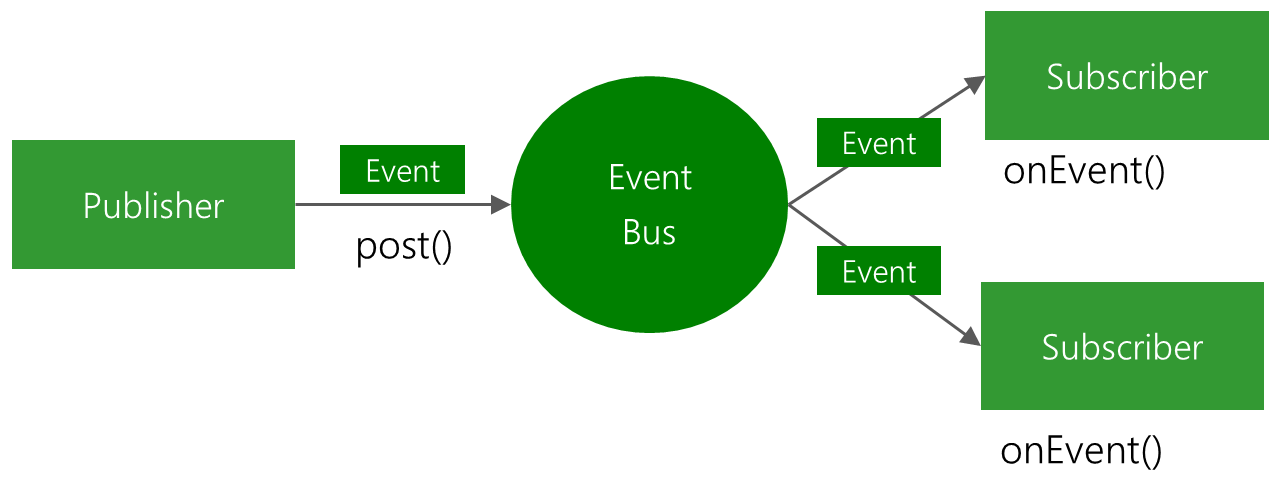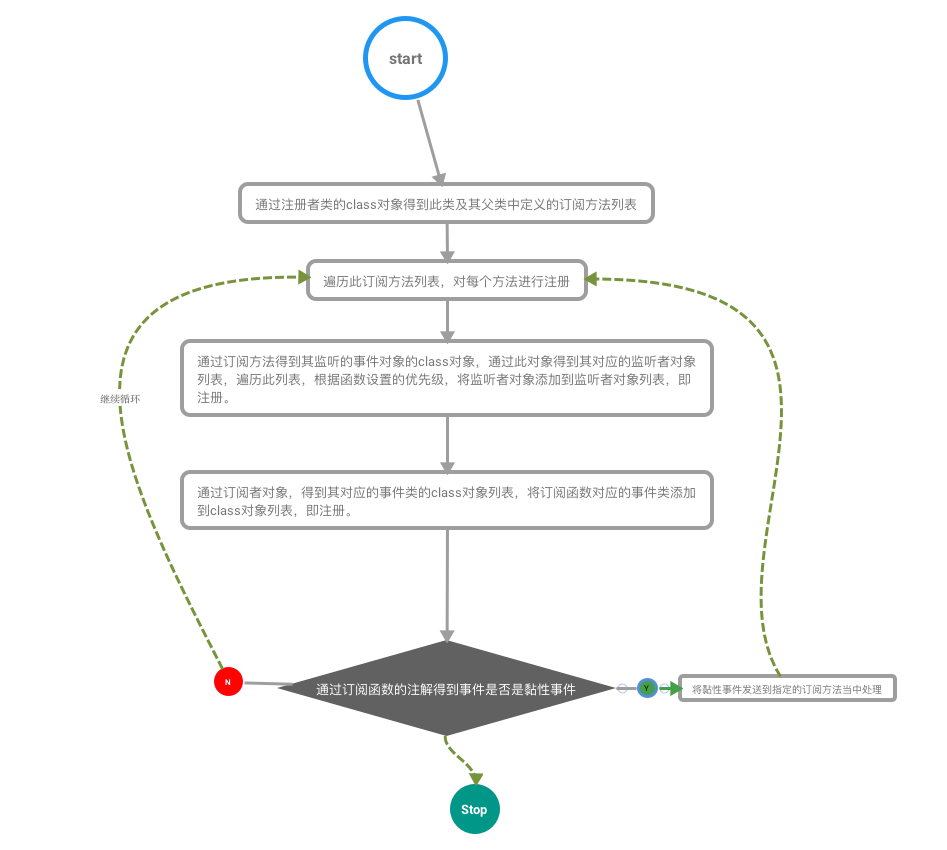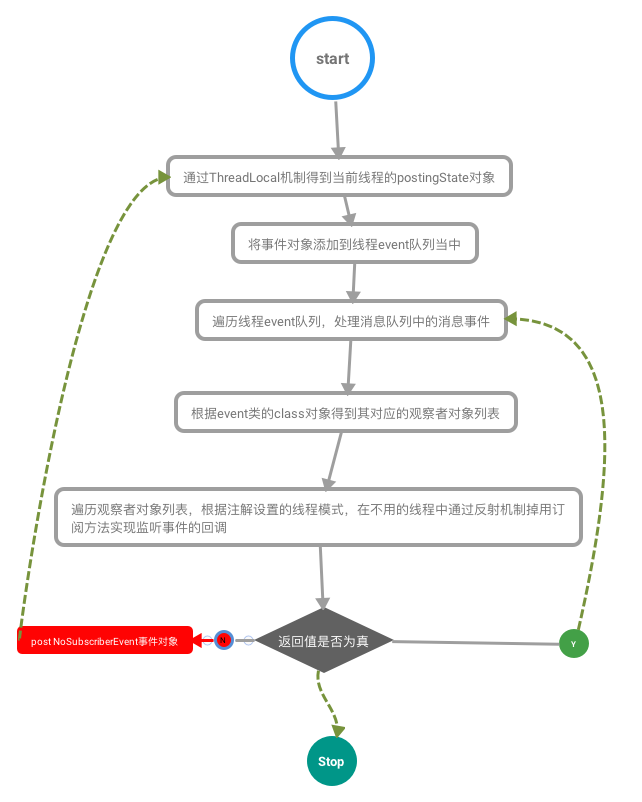- 游戏技术文章
Android开发事件总线之EventBus运用和框架原理深入理解
时间:2017-4-20 13:26:51 作者:棋牌资源网 来源:棋牌资源网 查看:6896 评论:0内容摘要:[Android]事件总线之EventBus的使用背景 在我们的android项目开发过程中,经常会有各个组件如activity,fragment和service之间,各个线程之间的通信需求;项目中用的最多的是Android框架的广播机制,android的广播机制是基于系统的B...[Android]事件总线之EventBus的使用背景在我们的android项目开发过程中,经常会有各个组件如activity,fragment和service之间,各个线程之间的通信需求;项目中用的最多的是Android框架的广播机制,android的广播机制是基于系统的Binder机制实现IPC或者进程内部的通信,而Binder这种IPC机制相比于Linux原有的机制来说具有,性能更好、安全性更高和易用性更好的特点,所以android系统中很多系统事件都是基于广播的方式来发送,如开机广播、电量低的提醒广播等。然而在一个android的进程内部,各个组件、子线程之间通信如果使用广播的话,那就有种杀鸡用牛刀的赶脚。。。
[Android]进程内部通信之EventBus
EventBus是greenrobot开发的发布/订阅事件总线组件,也是基于观察者模式,不同点在于,EventBus框架解耦了事件的发送和订阅模块,事件对象的分发交由EventBus来处理,下面的框架图可以清晰的看到这一点。

[Android]EventBus 3.0基本使用方法
一、定义事件类
作为事件的发布者,需要定义所发布的事件的类:
public class MessageEvent { private String msg; public MessageEvent(String msg) { this.msg = msg; } public String getMsg() { return msg; } public void setMsg(String msg) { this.msg = msg; } }二、注册/取消注册响应事件
作为事件的订阅者,需要把响应事件的对象注册到EventBus当中:
EventBus.getDefault().register(obj)
当不需要处理某个类型的事件的时候,取消对这个事件的监听:
EventBus.getDefault().unregister(obj)
三、声明和注释订阅方法,选择指定线程模式
作为事件的订阅者,需要定义事件的响应方法,方法名称可以随意取,方法的形参类型,必须和监听的事件对象类型一致:
@Subscribe(threadMode = ThreadMode.MAIN) public void onMessageEvent(MessageEvent event) { Toast.makeText(this, event.getMsg (), Toast.LENGTH_SHORT).show(); }3.1 四种线程模式
事件订阅者可以通过注解的方式选择处理事件的方法所在的线程:
PostThread:如果事件处理函数指定了线程模型为PostThread,那么事件的发布和接收处理会在同一个线程当中。
BackgroundThread:如果事件处理函数指定了线程模型为BackgroundThread,那么如果事件是在UI线程中发布出来的,那么该事件处理函数就会在新的子线程中运行,如果事件发布本来就是非UI线程中发布出来 的,那么该事件处理函数直接在发布事件的线程中执行。
MainThread:如果事件处理函数指定了线程模型为MainThread,那么不论事件对象是在哪个线程中发布出来的,该事件处理函数都会在UI线程中执行。
Async:如果事件处理函数指定了线程模型为Async,那么无论事件在哪个线程发布,该事件处理函数都会在新建的子线程中执行。
3.2 黏性事件
通过注解的方式设置sticky为true,那么事件处理函数则可以处理上一次的事件对象:
@Subscribe(sticky = true, threadMode = ThreadMode.MAIN)四、EventBus 3.0源码详解
4.1 注册流程
/** * Registers the given subscriber to receive events. Subscribers must call {@link #unregister(Object)} once they * are no longer interested in receiving events. * <p/> * Subscribers have event handling methods that must be annotated by {@link Subscribe}. * The {@link Subscribe} annotation also allows configuration like {@link * ThreadMode} and priority. */ public void register(Object subscriber) { //通过注册的对象得到其类的class对象 Class<?> subscriberClass = subscriber.getClass(); //通过类的class对象得到此对象的订阅方法列表 List<SubscriberMethod> subscriberMethods = subscriberMethodFinder.findSubscriberMethods(subscriberClass); synchronized (this) { for (SubscriberMethod subscriberMethod :subscriberMethods) { //线程同步,遍历订阅方法列表,注册每一个订阅方法 subscribe(subscriber, subscriberMethod); } } }代码subscriberMethodFinder.findSubscriberMethods(subscriberClass)获取订阅方法列表具体如下:
List<SubscriberMethod> findSubscriberMethods(Class<?> subscriberClass) { //在缓存中查找此class对象对应的订阅方法列表 List<SubscriberMethod> subscriberMethods = METHOD_CACHE.get(subscriberClass); if (subscriberMethods != null) { return subscriberMethods; } //是否忽略注解器生成的MyEventBusIndex类 if (ignoreGeneratedIndex) { //通过反射机制得到订阅者类class对象对应的订阅事件方法列表 subscriberMethods = findUsingReflection(subscriberClass); } else { //从注解器生成的MyEventBusIndex类中获得订阅类的订阅方法列表 subscriberMethods = findUsingInfo(subscriberClass); } if (subscriberMethods.isEmpty()) { throw new EventBusException("Subscriber " + subscriberClass + " and its super classes have no public methods with the @Subscribe annotation"); } else { //缓存此class对象的订阅方法列表 METHOD_CACHE.put(subscriberClass, subscriberMethods); return subscriberMethods; } }通过反射机制获取订阅方法列表:
private List<SubscriberMethod> findUsingReflection(Class<?> subscriberClass) { FindState findState = prepareFindState(); findState.initForSubscriber(subscriberClass); while (findState.clazz != null) { //遍历当前class对象和其父类中的订阅方法 findUsingReflectionInSingleClass(findState); findState.moveToSuperclass(); } return getMethodsAndRelease(findState); }findUsingReflectionInSingleClass方法:
private void findUsingReflectionInSingleClass(FindState findState) { Method[] methods; try { // This is faster than getMethods, especially when subscribers are fat classes like Activities methods = findState.clazz.getDeclaredMethods(); } catch (Throwable th) { // Workaround for java.lang.NoClassDefFoundError, see https://github.com/greenrobot/EventBus/issues/149 methods = findState.clazz.getMethods(); findState.skipSuperClasses = true; } //遍历此类的方法 for (Method method : methods) { int modifiers = method.getModifiers(); if ((modifiers & Modifier.PUBLIC) != 0 && (modifiers & MODIFIERS_IGNORE) == 0) { Class<?>[] parameterTypes = method.getParameterTypes(); //形参只有一个的函数 if (parameterTypes.length == 1) { //得到此函数的注解信息对象 Subscribe subscribeAnnotation = method.getAnnotation(Subscribe.class); if (subscribeAnnotation != null) { Class<?> eventType = parameterTypes[0]; if (findState.checkAdd(method, eventType)) { ThreadMode threadMode = subscribeAnnotation.threadMode(); findState.subscriberMethods.add(new SubscriberMethod(method, eventType, threadMode, subscribeAnnotation.priority(), subscribeAnnotation.sticky())); } } } else if (strictMethodVerification && method.isAnnotationPresent(Subscribe.class)) { String methodName = method.getDeclaringClass().getName() + "." + method.getName(); throw new EventBusException("@Subscribe method " + methodName + "must have exactly 1 parameter but has " + parameterTypes.length); } } else if (strictMethodVerification && method.isAnnotationPresent(Subscribe.class)) { String methodName = method.getDeclaringClass().getName() + "." + method.getName(); throw new EventBusException(methodName + " is a illegal @Subscribe method: must be public, non-static, and non-abstract"); } } }至此,我们得到了所有的订阅函数列表,下一步,会对每一个订阅函数进行注册:
// Must be called in synchronized block private void subscribe(Object subscriber, SubscriberMethod subscriberMethod) { Class<?> eventType = subscriberMethod.eventType; Subscription newSubscription = new Subscription(subscriber, subscriberMethod); //通过监听的事件对象得到其对应的监听者对象列表 CopyOnWriteArrayList<Subscription> subscriptions = subscriptionsByEventType.get(eventType); if (subscriptions == null) { subscriptions = new CopyOnWriteArrayList<>(); subscriptionsByEventType.put(eventType, subscriptions); } else { //如果这个对象已经在此事件对象的监听者列表当中,则抛出异常 if (subscriptions.contains(newSubscription)) { throw new EventBusException("Subscriber " + subscriber.getClass() + " already registered to event " + eventType); } } int size = subscriptions.size(); for (int i = 0; i <= size; i++) { //遍历监听者列表,根据订阅方法的优先级将新的监听对象插入到列表的指定位置,即订阅方法的注册 if (i == size || subscriberMethod.priority > subscriptions.get(i).subscriberMethod.priority) { subscriptions.add(i, newSubscription); break; } } //通过订阅者对象得到其对应的监听事件类型列表 List<Class<?>> subscribedEvents = typesBySubscriber.get(subscriber); if (subscribedEvents == null) { subscribedEvents = new ArrayList<>(); typesBySubscriber.put(subscriber, subscribedEvents); } //添加事件类型对象到此监听对象对应的事件对象列表当中 subscribedEvents.add(eventType); //在这里处理黏性事件 if (subscriberMethod.sticky) { if (eventInheritance) { // Existing sticky events of all subclasses of eventType have to be considered. // Note: Iterating over all events may be inefficient with lots of sticky events, // thus data structure should be changed to allow a more efficient lookup // (e.g. an additional map storing sub classes of super classes: Class -> List<Class>). Set<Map.Entry<Class<?>, Object>> entries = stickyEvents.entrySet(); for (Map.Entry<Class<?>, Object> entry : entries) { Class<?> candidateEventType = entry.getKey(); if (eventType.isAssignableFrom(candidateEventType)) { Object stickyEvent = entry.getValue(); //将黏性事件发送到指定的订阅方法当中处理 checkPostStickyEventToSubscription(newSubscription, stickyEvent); } } } else { Object stickyEvent = stickyEvents.get(eventType); //将黏性事件发送到指定的订阅方法当中处理 checkPostStickyEventToSubscription(newSubscription, stickyEvent); } }事件的注册流程实际是从监听者对象和消息事件两个维度,将对方分别添加到自己对应的列表当中,具体可以通过以下流程图总结:

4.2发布流程
/** Posts the given event to the event bus. */ public void post(Object event) { //通过ThreadLocal机制得到当前线程的postingState对象 PostingThreadState postingState = currentPostingThreadState.get(); List<Object> eventQueue = postingState.eventQueue; //在此线程的eventQueue中添加此事件对象 eventQueue.add(event); if (!postingState.isPosting) { //判断当前线程是否UI线程 postingState.isMainThread = Looper.getMainLooper() == Looper.myLooper(); postingState.isPosting = true; if (postingState.canceled) { throw new EventBusException("Internal error. Abort state was not reset"); } try { while (!eventQueue.isEmpty()) { //遍历此线程消息队列,处理消息队列中的消息事件 postSingleEvent(eventQueue.remove(0), postingState); } } finally { postingState.isPosting = false; postingState.isMainThread = false; } } }ThreadLocal机制可以存储各个线程的局部数据;
postSingleEvent函数处理此线程消息队列中的消息事件:private void postSingleEvent(Object event, PostingThreadState postingState) throws Error { Class<?> eventClass = event.getClass(); boolean subscriptionFound = false; if (eventInheritance) { //得到此事件类的所有父类和接口 List<Class<?>> eventTypes = lookupAllEventTypes(eventClass); int countTypes = eventTypes.size(); for (int h = 0; h < countTypes; h++) { Class<?> clazz = eventTypes.get(h); //通过事件类得到其对应的订阅者对象列表,将事件对象分发到相应的订阅函数中处理,至此实现了事件消息的传递 subscriptionFound |= postSingleEventForEventType(event, postingState, clazz); } } else { //通过事件类得到其对应的订阅者对象列表,将事件对象分发到相应的订阅函数中处理,至此实现了事件消息的传递 subscriptionFound = postSingleEventForEventType(event, postingState, eventClass); } if (!subscriptionFound) { if (logNoSubscriberMessages) { Log.d(TAG, "No subscribers registered for event " + eventClass); } if (sendNoSubscriberEvent && eventClass != NoSubscriberEvent.class && eventClass != SubscriberExceptionEvent.class) { post(new NoSubscriberEvent(this, event)); } } }事件消息对象具体的分发函数:postToSubscription
private void postToSubscription(Subscription subscription, Object event, boolean isMainThread) { //根据注解方式设置的线程模式,在不同的线程中执行订阅函数 switch (subscription.subscriberMethod.threadMode) { case POSTING: invokeSubscriber(subscription, event); break; case MAIN: if (isMainThread) { invokeSubscriber(subscription, event); } else { mainThreadPoster.enqueue(subscription, event); } break; case BACKGROUND: if (isMainThread) { backgroundPoster.enqueue(subscription, event); } else { invokeSubscriber(subscription, event); } break; case ASYNC: asyncPoster.enqueue(subscription, event); break; default: throw new IllegalStateException("Unknown thread mode: " + subscription.subscriberMethod.threadMode); } }至此,我们完成了事件消息对象的分发流程,以下流程图来总结post的过程:

4.3 取消注册流程
/** Unregisters the given subscriber from all event classes. */ public synchronized void unregister(Object subscriber) { //根据订阅者对象得到其对应的事件类型列表 List<Class<?>> subscribedTypes = typesBySubscriber.get(subscriber); if (subscribedTypes != null) { for (Class<?> eventType : subscribedTypes) { //遍历事件类型列表,得到每个事件类型对应的订阅者对象列表,遍历这个列表,如果是此观察者对象,则从列表中删除 unsubscribeByEventType(subscriber, eventType); } //typesBySubscriber中删除此订阅者对象 typesBySubscriber.remove(subscriber); } else { Log.w(TAG, "Subscriber to unregister was not registered before: " + subscriber.getClass()); } }unsubscribeByEventType函数:
/** Only updates subscriptionsByEventType, not typesBySubscriber! Caller must update typesBySubscriber. */ private void unsubscribeByEventType(Object subscriber, Class<?> eventType) { //根据事件类型得到其对应的订阅者对象列表 List<Subscription> subscriptions = subscriptionsByEventType.get(eventType); if (subscriptions != null) { int size = subscriptions.size(); for (int i = 0; i < size; i++) { Subscription subscription = subscriptions.get(i); //遍历列表,如果找到此订阅者对象则从列表中删除 if (subscription.subscriber == subscriber) { subscription.active = false; subscriptions.remove(i); i--; size--; } } } }取消注册的流程总结如下:
1.通过观察者类对象通过MAP表得到其对应的事件类class对象列表.
2.遍历list列表,通过事件类class对象得到其在MAP表中对应的观察者类对象列表。
3.遍历此观察者对象列表,判断如果列表中存在需要取消的注册观察者对象,则从对象列表中删除此观察者对象。
4.从第1步中得到的MAP对象中删除以取消注册的观察者对象为key的映射项目。
5.完成unregister过程。
五、相似功能框架的比较
和EventBus具有相似功能的组件有Square推出的Otto,Android系统的LocalBroadCast,共同点是这三个框架都是进程内通信,方便进程内各个组件和子线程间的通信。
Ottootto采用了注解的方式完成注册,Otto更多使用场景应该就是在主线程中,因为其不像EventBus可以选择不同的线程模式。
LocalBroadCast是Android在Android Support Library中提供的,用于进程内部通信框架,其主要目的是保证广播在进程内部传递,确保通讯的安全行,其内部通过handler的方式实现。
欢迎加入VIP,【VIP售价:只要288元永久VIP会员】畅享商业棋牌游戏程序下载,点击开通!
下载说明
☉本站所有源码和资源均由站长亲自测试-绝对保证都可以架设,运营!
☉如源码和资源有损坏或所有链接均不能下载,请告知管理员,☉本站软件和源码大部分为站长独资,资源购买和收集,放心下载!
☉唯一站长QQ:1004003180 [人格担保-本站注重诚信!]
☉购买建议E-mail:1004003180@qq.com 源码收购 E-mail:1004003180@qq.com
☉本站文件解压密码 【文章内都自带解压密码,每个密码不同!】
- 本类推荐
- 本类排行
-
10-30Androidkiller未检测到Java SDK环境怎么办
-
10-30未检测到Java SDK 环境-Java环境变量设置-Java开发环境搭建
-
10-30Android反编译工具的使用-Android Killer
-
10-8sqlserver2005 安装图解教程以及SQL 2005 SP3补丁安装图文教程
-
1-1SRC漏洞挖掘必备的12款浏览器插件(附下载地址)
-
11-6网络管理员必备的10个优秀的日志分析工具
-
3-24网络推广之20种新手引流推广方案详解
-
11-21【站长推荐阅读】竞价排名暴利赚钱的公开秘密
-
1-11C语言震荡波病毒源代码
-
4-3AG、BBIN、PT、MG、TTG、SA、DT、BS、PNG、MW、SW、CQ9、PP、PG、AB、OG等多款api开户游戏体验
-

